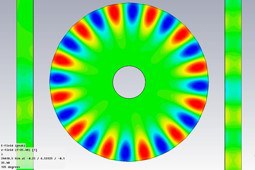Resonant approaches are the most accurate and sensitive techniques for microwave characterization of substances. Whispering-gallery mode (WGM) resonator technique provide advanced properties comprising open resonator system, high quality factor, accessibility of rigorous analysis of electromagnetic field distribution in the resonator, controllability of mode coupling with waveguide antennas [1-3]. Using microfluidic channels in the microwave band allows the contactless measurement of different liquids that is important for various biochemical applications. Recently we demonstrated that the technique based on a WGM resonator covered by a plastic layer with a microfluidic channel has additional advantages compared to other WGM techniques such as a closed measurement cell system and the utilization of a constant small amount (nL range) of the liquid under test (LUT). These advantages lead to increased accuracy and high sensitivity of the technique based on WGM resonator with the microfluidic channel. A novel approach allows obtaining the complex permittivity of biochemical LUTs of sub-microliter/nanoliter volumes with high accuracy. The method is based on special analysis procedure of the electromagnetic field interaction with liquid in WGM microfluidic resonator and measurements of both the WGM resonance frequency shift and the change of the inverse quality factor. The approach is successfully applied to obtain the complex permittivity in the Ka band of glucose, albumin bovine serum, lactalbumin and cytochrome C aqueous solutions using the developed microwave technique. It was shown that the presented measurement system allows measuring small concentration changes of liquid solutions in sub-microliter/nanoliter volumes. The approach enables the contactless determination of complex permittivity for small amounts of biological liquids in the microwave range with high measurement accuracy.
RECENT PUBLICATIONS:
[1] Microwave characterization of aqueous amino acid solutions using the multifrequency WGM resonator technique. Biological Chemistry. A. I. Gubin et al. Vol. 404, N. 2-3,229-235 (2023).
[2] Single Whispering-Gallery-Mode Resonator With Microfluidic Chip as a Basis for Multifrequency Microwave Permittivity Measurement of Liquids. A. I. Gubin et al. IEEE Transactions on Microwave Theory and Techniques. Vol. 70, N. 6, 3310-3318 (2022).
[3] Optimized Sensor for Broadband Dielectrometry of Biological Liquids of Small Volume, S. Pandey et al., 2021 51st European Microwave Conference (EuMC), London, United Kingdom, 2022, pp. 781-784, doi: 10.23919/EuMC50147.2022.9784378 (2022).
DFG Project: “Microwave dielectrometry of biological liquids of small volumes”
Leopoldina Project: “Multifunctional Materials Designed Using Nanoparticles and Liquid Crystals for Tunable Biosensor Applications”
Prof. Dr. Svetlana Vitusevich
Tel.: +49-2461-61-2345
e-mail: s.vitusevich@fz-juelich.de

